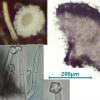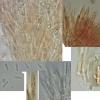
06-12-2025 00:19
 Viktorie Halasu
Viktorie Halasu
Hello, would anyone have this article, please? An

05-12-2025 17:33
 Bruno Coué
Bruno Coué
Bonjour, je serais heureux de recueillir votre avi

02-12-2025 18:59
This pair of ascos 2.5cm across were on recently b

02-12-2025 19:25
Buckwheat PeteHello, can anyone identify this hairy fungus growi

30-11-2025 12:53
 Edvin Johannesen
Edvin Johannesen
White short-stipitate apothecia found on thin twig

30-11-2025 10:47
 William Slosse
William Slosse
I recently found a collection of small Peziza sp.
For once the path through the main key of Raitviir (2004) was short: two steps to Graddonidiscus and in the genus key one step to G. vandae. Then the problems start.
This fungus was growing on an old leaf of Vaccinium myrtillus(?) attached to a dropping of elk (Alces alces) in a boggy habitat, just a few minute scattered apos. Finland. Spores 4.7 - 5.6 × 1.4 - 1.9 µm; asci approx. 25 x 3-4; paraphyses lanceolate, about 45 x 5; ectal excipulum textura prismatica.
I would appreciate any help with this.
Stefan

Hi Stefan,
To me this looks like Lachnum rhytismatis with its crystal-capped hairs combined with the substrate. I remember finding quite frquent ascomata on fallen leaves of Vaccinium myrtillus.
Best wishes,
Charles.


